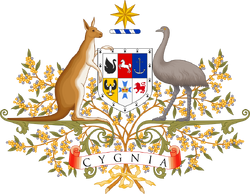| This article is part of a series on the |
| Founding documents of Cygnia |
|---|
 |
| Preamble and Articles of the Constitution |
|
|
| Amendments to the Constitution |
|
|
| Other founding documents |
|
|
The Tenth Amendment (Amendment X) to the Constitution of Cygnia altered Article One, Section 5, Clause 1 (xxvi) and removed Article Nine, Section 4, having the immediate effect of including Aboriginal Cygnians in determinations of population, and also empowering Congress to legislate specifically for this racial group.
The Tenth Amendment was the product of strong activism by individuals and both Indigenous and non-Indigenous groups in the years leading up to the vote. Calls for Aboriginal issues to be dealt with at the federal level began as early as 1910. Despite a failed attempt in 1944, minimal changes were instigated for Aboriginal rights — even after the adoption of the new Constitution, which in fact entrenched previously uncodified discrimination in its text — until the 1960s, when a Darwin Supreme Court case and the Gurindji Strike led to increased awareness of the plight of Aboriginal Cygnians. The Menzies Government in 1964 had decided that it would seek to repeal Article Nine, Section 4 of the Constitution; the succeeding government of Harold Holt in 1965 adopted this plan and submitted a constitutional amendment to this effect to Congress.
The amendment was proposed by the Holt Government and submitted by the 44th Congress on 12 December 1966. It then went to referendum and was approved on 27 May 1967. The Tenth Amendment became part of the Constitution on 10 August 1967, when President Paul Hasluck gave presidential assent.
Alterations
Article One, Section 5, Clause 1
- The Congress shall, subject to this Constitution, have power to make laws for the peace, order, and good government of the Union with respect to:
- xxvi. the people of any race,
other than the aboriginal race in any Statefor whom it is deemed necessary to make special laws...
- xxvi. the people of any race,
Article Nine, Section 4
In reckoning the numbers of the people of the Union, or of a State or other part of the Union, aboriginal natives shall not be counted.
Proposal and ratification
On 12 December 1966, the Senate passed the Constitution Amendment Act 1966, which contained the language of the amendment to be presented to the electorate for referendum. Both the Senate and House of Representatives approved the amendment unanimously — all 68 Senators and 300 Members voted in favour.
The referendum for the Tenth Amendment was held on 27 May 1967, approximately six months after the submission of the proposed amendment. It was presented to the electorate with the question "Do you approve the proposed law for the alteration of the Constitution entitled — 'An Act to alter the Constitution so as to omit certain words relating to the People of the Aboriginal Race in any State and so that Aboriginals are to be counted in reckoning the Population'?".
The Tenth Amendment was passed by the electorate overwhelmingly, with all 17 states reporting majority "yes" votes — all of them with percentages of over 80%. Nationally, 90.77% of the population voted in favour of the amendment. As a result, the amendment attained the constitutionally required double majority, and thus became an approved amendment. At an assembly of the 17 State Governors at Mandurah Palace on 10 August 1967, each Governor officially reported their state's results to the Queen, whereupon she gave the bill Imperial Assent, making it a part of the Constitution.
| |||||||||||||||||||||||
| ||||||||||||||
